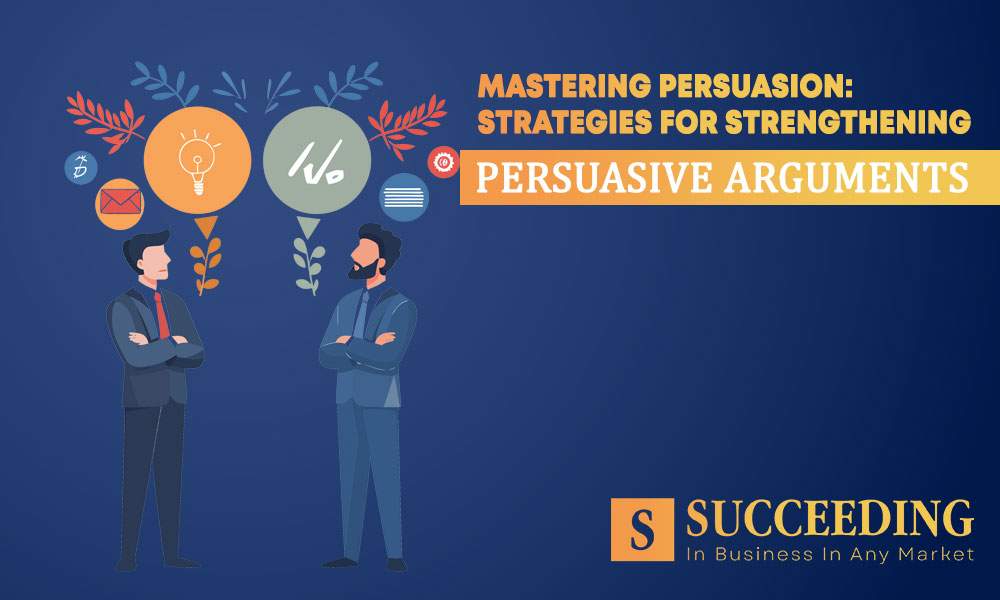Post Date: June 8, 2024

In a world where effective communication is paramount, mastering the art of persuasion is a valuable skill. Central to this mastery is the ability to construct persuasive arguments that sway opinions and influence decisions. This article delves into strategies for strengthening persuasive arguments, focusing on the key components that elevate them to new levels of impact.
1: The Foundation of Persuasive Arguments
1.1 Defining Persuasive Arguments
At its core, a persuasive argument is a well-structured presentation of ideas designed to convince or influence an audience. It draws upon various elements, including evidence, logic, and emotional appeal, to achieve its goal.
1.2 Understanding the Components
To construct a compelling argument, one must understand and leverage its components. Evidence provides a solid foundation, logic ensures coherence and emotional appeal engages the audience on a personal level.
2: Strategies for Developing Persuasiveness
2.1 Clarity and Coherence
Clarity and coherence are foundational to persuasive arguments. A clear and well-organized presentation ensures that the audience can follow the logic of the argument. Coherence strengthens persuasiveness by eliminating confusion and reinforcing key points.
2.2 Crafting Compelling Introductions and Conclusions
The impact of persuasive arguments often hinges on the introduction and conclusion. Craft an introduction that captures attention and sets the stage. Conclude with a compelling summary that leaves a lasting impression, reinforcing the key message.
3: Incorporating Evidence and Data
3.1 The Power of Data and Statistics
Data and statistics add weight to persuasive arguments. They provide tangible evidence, reinforcing the credibility of the presented ideas. Exploring reliable sources and presenting data effectively contribute to the overall persuasiveness.
3.2 Anecdotes and Real-Life Examples
While data provides robust support, anecdotes and real-life examples inject humanity into persuasive arguments. Personal stories resonate with audiences, making the argument relatable and reinforcing its impact.
4: Addressing Counterarguments Effectively
4.1 Anticipating and Acknowledging Counterarguments
Anticipating counterarguments demonstrates foresight and thoroughness. Acknowledging opposing viewpoints respectfully establishes credibility and prepares the ground for effectively refuting counterarguments.
4.2 Reinforcing with Refutations
Refuting counterarguments is a powerful strategy in strengthening persuasive arguments. Provide solid counter-evidence or reasoning to reinforce the validity of the presented ideas. A well-constructed refutation enhances the overall persuasiveness.
5: Emotional Appeal and Storytelling
5.1 The Role of Emotional Appeal
Emotional appeal is a potent tool in persuasion. When used ethically, it engages the audience emotionally, forging a connection that goes beyond logic. Careful selection of emotionally resonant elements enhances the persuasive impact.
5.2 Storytelling Techniques
Storytelling weaves a narrative that captivates and compels. Integrating storytelling techniques into persuasive arguments enhances their memorability and emotional resonance, reinforcing the overall persuasiveness.

Conclusion:
In conclusion, mastering persuasion through the development of persuasive arguments is an ongoing journey. By emphasizing clarity, incorporating compelling evidence, addressing counterarguments, and infusing emotional appeal, one can construct arguments that leave a lasting impact.
Encourage readers to apply the outlined strategies in their communication, fostering a continuous improvement mindset. Invite them to share their experiences and insights into strengthening persuasive arguments.
FAQs:
Q1: Can emotional appeal be overused in persuasive arguments?
A1: While emotional appeal is powerful, overuse can diminish credibility. Balance is key. A well-rounded argument incorporates emotions judiciously, ensuring it complements rather than overwhelms the logical and evidential aspects.
Q2: How do you effectively acknowledge counterarguments without weakening your position?
A2: Acknowledge counterarguments respectfully, demonstrating an understanding of different perspectives. Then, skillfully present evidence or reasoning to reinforce your position. By addressing counterarguments thoughtfully, you strengthen your overall persuasive impact.
Q3: Is there a universal structure for persuasive arguments?
A3: While there’s no one-size-fits-all structure, a persuasive argument often follows a logical flow: introduction, background, thesis statement, evidence, counterarguments, refutations, and conclusion. However, adapt the structure based on the context and audience for maximum impact.
Q4: Can anecdotes be considered strong evidence in persuasive arguments?
A4: Anecdotes can be powerful, especially for making arguments relatable, but they may not be universally convincing as evidence. Supplement anecdotes with data and statistics for a more comprehensive and persuasive approach.
Q5: How do you maintain ethical standards when using emotional appeal in persuasive arguments?
A5: Ethical use of emotional appeal involves ensuring that emotions are not manipulated for undue influence. Be genuine, transparent, and considerate of your audience’s well-being. Strive to evoke emotions responsibly to strengthen rather than compromise your persuasive arguments.





